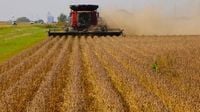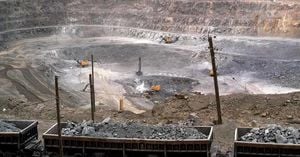As the autumn harvest sweeps across the American Midwest, soybean farmers find themselves caught in a perfect storm of international politics, economic competition, and frustration with their own government’s decisions. The heartland’s signature crop, once a linchpin in U.S.-China trade, has become a casualty of both global maneuvering and domestic policy, leaving many growers wondering just who’s looking out for their interests.
On October 1, 2025, President Donald Trump took to Truth Social to announce that soybeans would be a major topic of discussion when he meets with Chinese President Xi Jinping in late October. “The Soybean Farmers of our Country are being hurt because China is, for ‘negotiating’ reasons only, not buying,” Trump wrote, highlighting the ongoing trade war between Washington and Beijing. According to Reuters, Chinese importers have yet to purchase any soybeans from the autumn 2025 U.S. harvest, costing American farmers billions in lost sales during what should be their busiest season.
Autumn is traditionally the prime marketing window for U.S. soybeans. As combines rumble through fields from Nebraska to the Carolinas, farmers expect to see their hard work rewarded with sales to China, the world’s largest soybean importer. Not this year. Instead, China has turned its attention southward, striking deals with South American suppliers and leaving U.S. prices under pressure.
The situation took an unexpected turn when the U.S. government approved a $20 billion financial bailout for Argentina, one of America’s chief competitors in the global soybean market. The move, which was intended to stabilize Argentina’s economy, instead had an immediate and dramatic impact on the soybean trade. As reported by Central Nebraska Today, Argentina responded by eliminating its export taxes on soybeans, making its beans significantly cheaper on the world market. China wasted no time, immediately purchasing over 1 million tons of Argentine soybeans. Meanwhile, not a single bushel from Nebraska’s 2025 harvest has found its way to Chinese ports.
This sequence of events has left many in the Midwest stunned—and angry. Dan Osborn, an independent U.S. Senate candidate from Nebraska, voiced the frustration felt by many rural Americans. “I was astonished when I heard about this,” Osborn said. “Our own government – which supposedly exists to promote the interests of our people – just gave Argentina the ability to undercut our farmers and steal our biggest customer. Nebraska farmers are struggling right now, so when our government uses our resources to bail out our competitors, something is really, really wrong.”
Osborn’s outrage is echoed by lawmakers on both sides of the aisle. Senator Chuck Grassley, a Republican from Iowa and a family farmer himself, took to social media on October 2 to vent his disbelief: “Why would USA help bail out Argentina while they take American soybean producers’ biggest market??? We shld use leverage at every turn to help hurting farm economy. Family farmers shld be top of mind in negotiations by representatives of USA.”
The anger is palpable across the Midwest. For many farmers, the government’s decision to help Argentina—just as that country was poised to capitalize on China’s absence from the U.S. market—feels like a double blow. Not only are American farmers losing out due to the ongoing trade war, but they are also watching their own tax dollars help a competitor seize vital market share.
Senator John Hoeven of North Dakota, another leading advocate for agricultural interests, offered little comfort after a briefing with U.S. Ambassador to China David Perdue. Hoeven said he didn’t think there was any specific timeline for China to resume purchases of U.S. soybeans. That uncertainty only adds to the anxiety gripping rural communities already battered by volatile prices, rising input costs, and unpredictable weather.
The stakes are enormous. Soybeans are the United States’ most valuable agricultural export, and China has long been its biggest customer. In a typical year, American farmers ship tens of millions of tons of soybeans to China, generating billions of dollars in revenue and supporting thousands of jobs. The absence of Chinese buyers this autumn is more than an inconvenience—it’s a potential crisis for rural economies.
Industry analysts point out that China’s pivot to South American suppliers is not just a short-term negotiating tactic. Over the past decade, Brazil and Argentina have invested heavily in expanding soybean production and infrastructure, making them formidable competitors. With Argentina’s export taxes now eliminated, its beans are more attractive than ever to price-sensitive buyers like China. The U.S. government’s bailout, intended as an act of international financial stewardship, has inadvertently tipped the scales further in South America’s favor.
For American farmers, the timing couldn’t be worse. Input costs—from fertilizer to diesel—remain high, and many have already taken on debt to finance this year’s planting. The loss of the Chinese market, even temporarily, could mean the difference between a profitable year and financial hardship. As one Nebraska farmer put it to Central Nebraska Today, “It’s like watching your best customer walk out the door, and then realizing your own government just paid for their cab.”
There’s little consensus in Washington about how to resolve the impasse. Some lawmakers, like Senator Grassley, urge the administration to use every bit of leverage in upcoming negotiations with China to prioritize family farmers. Others warn that the global soybean market is shifting in ways that may not be easily reversed, regardless of diplomatic breakthroughs. The trade war, now stretching into its seventh year, has already forced many U.S. exporters to seek new markets in Europe, Southeast Asia, and beyond—but none can match the scale of Chinese demand.
President Trump, for his part, has signaled that he intends to press the issue directly with President Xi. But with the next round of talks still weeks away, and no clear timeline for a resolution, farmers are left to hope for a breakthrough that may or may not come in time to salvage this year’s harvest.
Meanwhile, the combines keep rolling, and the bins keep filling. In farm towns across Nebraska, Iowa, and the Dakotas, the mood is a mixture of pride in the harvest and anxiety about what comes next. As Osborn put it, “We’re using our own tax dollars to help a foreign competitor steal our biggest customer.” For now, the soybean fields stand as silent witnesses to a global drama playing out far beyond the fencerows—and the outcome remains anyone’s guess.




